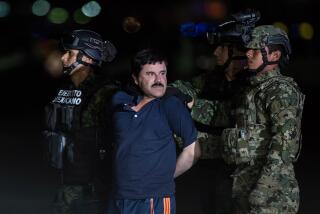Honduras Leaves Key Border Area to Contras and Their Sandinista Foes
- Share via
TEGUCIGALPA, Honduras — This country has all but abandoned a part of its own territory to U.S.-backed Nicaraguan rebels and Sandinista troops who are pursuing them, Honduran and foreign officials here say.
The abandoned area is known as the Las Vegas salient, a triangular, mountainous frontier region 90 miles east of Tegucigalpa where the border dips south toward Nicaragua.
The Nicaraguan contras have maintained bases there for about five years, and thousands of them are reported to be in the pine-forested region, resting or awaiting the opportunity to infiltrate across the nearby frontier into Nicaragua.
Since July, sources say, Nicaragua’s Sandinista government has kept up to 1,000 regular troops on virtually permanent patrol inside the triangle.
For its part, Honduras stations no more than 40 troops at any one time near Las Vegas, the sources say.
Ceded Territory to Contras
“I think the Hondurans have drawn lines, ceded territory to the contras,” a Western diplomat said. “That way, they don’t have to risk losing lives and thus get involved.”
Roberto Suazo Tome, the Honduran Foreign Ministry official in charge of Central American affairs, explained: “The conflict between Nicaraguan troops and the contras is a problem that involves only Nicaraguans.”
The withdrawal of Honduran troops from the Las Vegas combat zone exemplifies the government’s looking-glass response to the presence of the contras. Officially, the government maintains the fiction that no Nicaraguan rebel bases exist inside this country.
Unofficially, by keeping their own soldiers away, the Hondurans can argue that they never come across any contras on their territory. Moreover, turning a blind eye to Nicaraguan incursions on Honduran soil permits the government here to assure the Sandinistas that it has no intentions of going to war with Nicaragua.
“Open conflict between Nicaragua and Honduras does not exist,” Suazo Tome emphasized in an interview, although he added that “exchange of fire” between Honduran and Nicaraguan troops occurs frequently along that part of the border where Honduras does maintain guard posts.
U.S. officials fear that Honduran abandonment of the strategic Las Vegas area will tempt the Nicaraguans to stage major preemptive, cross-border strikes against contra forces. Many contras are awaiting training and equipment inside Honduras, and any Sandinista attacks force the rebels to expend manpower and supplies defending their base camps.
In October, Nicaraguan soldiers and contras clashed in the Las Vegas salient while Honduran troops kept away and the Honduran government remained silent. It was the biggest anti-contras drive since March, when Sandinista troops stormed rebel camps deep inside Honduras. Only heavy pressure by the U.S. government forced the Hondurans to protest the action--and then only after the fighting had stopped.
Hands Off Impossible
Despite the best Honduran efforts to keep the contras-Sandinista conflict at arms length, several factors make a complete hands-off policy impossible.
First, when Honduran troops do get involved, resulting casualties force the government to complain.
On Friday, the Honduran government sent a note to the Sandinistas protesting the wounding of three Honduran soldiers by Sandinista troops seven miles inside Honduras. Two Honduran soldiers were also captured, the note added.
“The attack . . . is considered by my government as an act of complete hostility and a threat to the peaceful relations between both states,” Foreign Minister Carlos Lopez Contreras said in the note. The protest demanded the release of the two prisoners and the return of captured Honduran arms.
Many Residents Flee
Hundreds of residents of the Las Vegas area have fled contras-Sandinista fighting in recent months, creating a social and political problem for the government.
In addition, while discussion of the contras’ presence was once taboo here in the capital, Honduran politicians now openly debate the issue.
“The irregular forces (contras) should carry out their struggle in Nicaragua,” said Rafael Callejas, an opposition politician and a defeated presidential candidate in last year’s elections.
The movement of all contras into Nicaragua would, of course, resolve Honduras’ dilemma. However, foreign observers here say that realistically it will be a long time before the rebels can operate solely inside Nicaragua. First, many contra fighters are still poorly trained and under-equipped. The first resources to flow from the $100 million in military and other aid approved by Congress earlier this fall is only now beginning to arrive at contra units. Second, there is no indication that, with aid or without it, the contras can soon secure a part of Nicaraguan territory from which to operate.
Moreover, continued supplies are expected to be funneled through Honduran territory for the foreseeable future.
For its part, the Nicaraguan government appears more concerned about the possible involvement of U.S. troops in Honduras than about any home-grown Honduran response. During the past week, Nicaraguan President Daniel Ortega charged that U.S. troops were on the way to the frontier to battle Sandinista soldiers and that the Americans were shelling Sandinista positions inside Nicaragua.
At present, about 100 troops from the Florida National Guard are on maneuvers in Honduras, but their artillery is well out of range of the border.
Another 1,000 U.S. troops, including intelligence personnel, are stationed semi-permanently in Honduras at various bases throughout the country.
More to Read
Sign up for Essential California
The most important California stories and recommendations in your inbox every morning.
You may occasionally receive promotional content from the Los Angeles Times.










